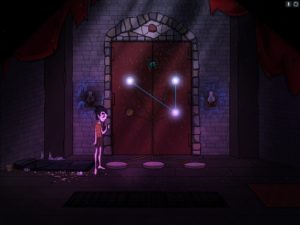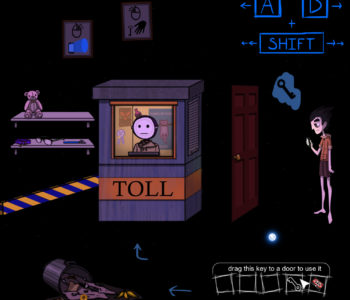
Puzzle Design and Signposting
The Puzzle Design

The Campsite Door puzzle is the last puzzle that faces the player in our short Endora’s Box demo. I wanted to challenge my design skills for this one, so the solution to this puzzle is actually based on a joke. My goal was to see if I could take a solution that is unintuitive and present it in a way that’s still fair and interesting to solve by using good signposting. As this game is designed around subversion, I wanted to build up to this huge and impressive conclusion, but have the reality be something much smaller and insignificant.
Goals:
- Take a seemingly insignificant object (tin can) and make it seem incredibly important, without explaining why, or even stating that it is important.
- I wanted the players to experience a moment of “Oh, I get it now, that’s funny” on completion.
- I wanted to avoid the players resorting to brute forcing the combination.
- I wanted to avoid the player solving the puzzle, but not understanding why.
The Mechanics

The puzzle involves a door that has a set of five orbs that can be touched. When touched, a line is drawn between them. There are also three plates on the ground that when stepped on by the player, will switch the orbs between three saved sets. In a pivotal meeting with the games mysterious antagonist Bugaboo, he mentions that the path is blocked by a difficult test and gives you a single object to help: a tin can. The core concept of the puzzle is that all of the drawings on the door need to spell out CAN.
Testing the concept:

Starting with a paper prototype, I sat testers down with only a few instructions:
- I will stop you when you’ve completed the puzzle.
- The coin represents you, you can move it along the arrow.
- The squares represent floor switches
- The CAN is an item in your inventory. You can use it on anything in the screen by placing it where you want to use it.
- You can draw a single, unbroken line through any of the circles in the door frame. The line may not touch the same circle twice.
- Simon is a character that you can talk to.
- The Trash is for discarding items.
I explained nothing further, so the testers could discover the other rules through interaction. As a test mediator, here are the rules I followed:
- When the testers moved the coin to another square in the arrow, I would switch door between the three copies, making sure that the first door always corresponded with the first floor switch and so on.
- When one of the drawn lines touched the same orb twice, I would erase the entire line.
- When using the CAN on the trash, Simon, the Door, or the floor switches, I would place a piece of paper on the board for the appropriate text, such as “This item CAN not be discarded”, or “This is a CAN”. I needed to do this instead of reading the lines to test the effect of spelling CAN in all capital letters to build suspicion of its importance.
Test Results:
After seven tests with people of different gaming experience, I found that everyone knew that the can was important, but very few could figure out why.
Only one person solved the puzzle because they understood the connection between the three symbols input into the door, and the three letters of “CAN”. Because of the low completion rate of my test, I realized that I could not rely only on the connection between “CAN” and the three input symbols.
Refined Design:

For my revision, I designed a three paths of clues to reach the puzzle conclusion:
Logic: Use the blacklight to see the hidden hint lines over the input orbs. These lines are an overlay of all three solutions put on top of each other. Using this new hint, a player can logically rule out 3 possible connections between 4 of the 5 orbs.
Exploration: Three notebook pages can be found that show the solution to the puzzle. The notes aren’t all hidden in plain sight however, and won’t necessarily be in order when picked up. One of them is found on the floor near the door and is labeled as “Note 2/3” to show that it is only a third of the solution, and more exploration may reveal the other two notes.
Humor: Several hints are given that the can object is important. When trying to discard the can, it is not discarded. Instead, text appears saying “This item CAN not be discarded”. Looking closely at the can or the three notes, it is labeled with text drawn in the same five point style as the door, even with the extra line protruding from the tip of the N. Any time the can is referred to in game, it is spelled in capital letters (CAN) to draw attention to the shape of the letters, which are the solution to the door. Players who see the importance of the word “CAN”, and who also notice there are three symbols needed for the door, may enter the word to see if it works.
Getting Familiar:

Another trick I used, is to remove one orb from the puzzle so that the player knows it can’t be completed, but is allowed to play around and get familiar with how it works. The most important part of this change is that the player starts on the left side of the room, and must walk over all three floor switches to progress to the room on the right where they are given the CAN. When they step on the switches, they will see that the door changes between the three sets. To further illustrate that there are in fact three separate symbols, each one already has an incorrect drawing set when you arrive to the room. With these changed alone I’ve already explained how the puzzle works to the player, without even one word spoken.






